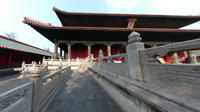You are in: Asia -> China -> Temple and Cemetery ... , and traditional search or Image Gallery will yield results of this site only
Temple and Cemetery of Confucius and the Kong Family Mansion in Qufu
| Site number: | 704 |
|
| Type of site: | Cultural | |
| Date: | 478 c. BC | |
| Date of Inscription: | 1994 | |
| Location: | Asia, China, Shandong Province, Qufu City | |
Up to 75 images are shown here. Click on each for more details or on Image Gallery for more images.
| Description: | Confucius, the great philosopher, politician and educator of the 6th–5th centuries B.C., has his temple, cemetery and family mansion located at Qufu, in Shandong Province. The structures were built in 478 B.C. to commemorate him, and though the temple has been repeatedly destroyed and reconstructed over the centuries, today the site encompasses more than 100 buildings. The cemetery is the resting place of Confucius as well as the remains of more than 100,000 of his descendants. The originally quite miniature house of the Kong family developed into a gigantic aristocratic residence, today 152 its buildings remain. Due to the commitment of successive Chinese emperors for more than 2,000 years, the Qufu complex of monuments has managed to retain its outstanding artistic and historic character. --WHMNet paraphrase from the description at WHC Site, where additional information is available. For 360 degree imaging of this site, click here. | |
| The temple complex is the second largest historical building complex in China (after the Forbidden City), it covers an area of 16,000 square metres and has a total of 460 rooms. Because the last major redesign following the fire in 1499 took place shortly after the building of the Forbidden City in the Ming Dynasty, the architecture of the Temple of Confucius resembles that of the Forbidden City in many ways. The main part of the temple consists of 9 courtyards arranged on a central axis, which is oriented in the north-south direction and is 1.3 km in length. The first three courtyards have small gates and are planted with tall pine trees, they serve an introductory function. --Wikipedia. Text is available under the Creative Commons Attribution-ShareAlike License. For 360 degree imaging of this site, click here. | ||
| Source: | http://whc.unesco.org/en/list/704 | |
| Reference: | 1. UNESCO World Heritage Center, Site Page. | |












































































